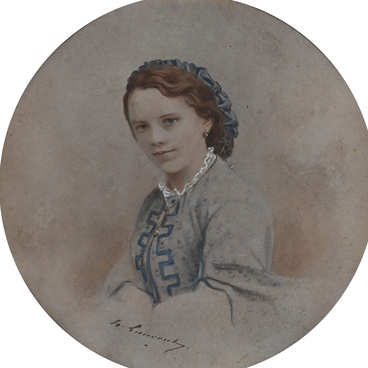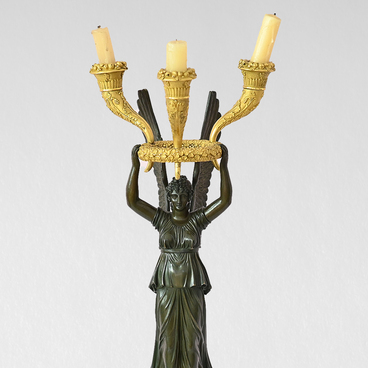The exhibition displays the painting ‘On the seashore’ by an unknown artist. In the center of the composition, the author depicted two moored sailing ships with colored flags fluttering on their masts. On the raised sail of one of them, one can see the letters ‘DR’. Two women stand on the sand among the rocks, and a child sits beside them.
The genre of fine art depicting a seascape or a scene of a naval battle is called ‘marine art’. As an independent type of landscape painting maritime painting appeared in the early 17th century in the Netherlands. Whereas the 16th century artists depicted mainly naval battles and paid attention to the details of ships’ equipment, the main motif of marine artworks in the 17th century was the image of the water itself in different weather conditions and different lighting.
In the 19th century, it was fashionable to decorate the walls of dining rooms, offices and halls of noble houses with seascapes. Such works were also displayed in the Tchaikovsky’s family house.
The composer’s father Ilya Tchaikovsky worked as a chief of mining at the Votkinsk factory, and he was engaged in the development of shipbuilding at the plant.
On September 6, 1847, the construction of the first in Russia iron steamship was solemnly started at the Votkinsk shipyard. It was named after the Persian town of Esterabad and intended for the Caspian Sea. Almost all residents of the settlement, where the shipyard was located, gathered in the spring of 1848 to watch the ceremonial launch of the steamship “onto the big water”, and Pyotr Tchaikovsky, the 8-year-old son of the shipyard’s chief, was one of the first passengers of the Esterabad. He traveled with his father along the Kama River to the Ust-Rechka dock. The young Tchaikovsky wrote about this event in his diary: ‘The steamship looks very beautiful, it has three cabins with windows, but it goes very slowly — two versts per hour…’ (a verst was a Russian measure of length, about 1.1 km).
Over almost 80 years of existence, the shipyard built more than 400 vessels of different classes and types: passenger ships, oil tankers, tugboats, launches and others. In addition, the plant produced iron, anchors, railway equipment and bridges, steam locomotives, excavators, gold dredges, various armaments, civil and industrial equipment.
The genre of fine art depicting a seascape or a scene of a naval battle is called ‘marine art’. As an independent type of landscape painting maritime painting appeared in the early 17th century in the Netherlands. Whereas the 16th century artists depicted mainly naval battles and paid attention to the details of ships’ equipment, the main motif of marine artworks in the 17th century was the image of the water itself in different weather conditions and different lighting.
In the 19th century, it was fashionable to decorate the walls of dining rooms, offices and halls of noble houses with seascapes. Such works were also displayed in the Tchaikovsky’s family house.
The composer’s father Ilya Tchaikovsky worked as a chief of mining at the Votkinsk factory, and he was engaged in the development of shipbuilding at the plant.
On September 6, 1847, the construction of the first in Russia iron steamship was solemnly started at the Votkinsk shipyard. It was named after the Persian town of Esterabad and intended for the Caspian Sea. Almost all residents of the settlement, where the shipyard was located, gathered in the spring of 1848 to watch the ceremonial launch of the steamship “onto the big water”, and Pyotr Tchaikovsky, the 8-year-old son of the shipyard’s chief, was one of the first passengers of the Esterabad. He traveled with his father along the Kama River to the Ust-Rechka dock. The young Tchaikovsky wrote about this event in his diary: ‘The steamship looks very beautiful, it has three cabins with windows, but it goes very slowly — two versts per hour…’ (a verst was a Russian measure of length, about 1.1 km).
Over almost 80 years of existence, the shipyard built more than 400 vessels of different classes and types: passenger ships, oil tankers, tugboats, launches and others. In addition, the plant produced iron, anchors, railway equipment and bridges, steam locomotives, excavators, gold dredges, various armaments, civil and industrial equipment.



